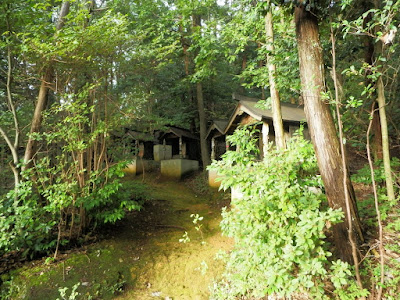Temple number 15, and for me, number two.
| ||
| From Kansai by the Seat |
I realized belatedly that the idea of going in order was not
only unnecessarily, but already had been violated by me when I purchased my
book and had it stamped at Nariai-ji. I was so hot to get on the pilgrimage but
I hadn’t realized I was already on it.
And even though my reasons for going on it have evolved with
new knowledge and with encouragement from a Buddhist nun of Australian origin,
I still wanted to do it Right, and In Order, insofar as I could.
But since the typhoon had sort of effed up that plan…
My first planned temple visit was Imakumano Kannon-ji.
I’m going to share here what struck me most about the place,
and for more detailed information (and also the source for most of whatever
info I can share) please see this page (specifically, here for temple 15), replete with photos and great
information.
I used my phone to navigate me into the temple, so it took
me the back way. This meant I missed out on crossing the special gateway bridge
at first, but got to do it on the way out.
| ||
| From Kansai by the Seat |
 |
| From Kansai by the Seat |
The gateway bridge is in lieu of a classic large gate that
temples usually have. The orange bridge is connected to the Kumano Gongen spirit,
and takes the place of the vermillion torii gate you often see at the entrance
to shrines (not temples).
One of the first things I saw, though, was the path through
the graveyard area behind the temple. Then I saw the main temple building. I
found my way around to the front and got a good look at a pretty interesting
statue: Kobo Daisha. It’s called the Komamori Daishi, which means
child-protecting Daishi. Apparently, Kobo Daishi opened the first school in
Japan that was available to all children, and not just noble-born boys. Being
involved in education myself, I gave my own special little salute to this
statue.
 |
| From Kansai by the Seat |
Another striking thing I discovered was the image of
Bokefuji Kannon. I’m used to seeing images of Buddha or others holding/caring
for babies, especially the mizuko
(stillborn, aborted, or miscarried babies), but this statue of Kannon is
flanked by old people, not children. Bokefuji Kannon is the one you pray to if
you want to prevent senile dementia.
Since there are so very many old people in Japan, this seems a good
image to have around; it’s not something I’ve thought seriously about in my own
case, because at least for now, senility seems far enough off.
 |
| From Kansai by the Seat |
In the main temple area, I lit some incense and got my book
stamped. The friendly priests told me I could go inside if I liked. I took off
my shoes and sat a little while, too haunt to take photos right there, instead
staring at the decoration and offerings, the bell and meditative.. what,
equipment? and thought about what kind of quest it was I might be on, and what
I was doing there.
 |
| From Kansai by the Seat |
On the temple grounds, there’s also a mini shrine to Kumano
Gongen, the Shinto version of the Juichimen Kannon (eleven-faced Kannon),
enshrined more grandly in Wakayama. I said a little prayer here for the
recovery of the Kumano’s home area. Next to it is a little Inari shrine. I love
the Inari, those foxy tricksters of good harvest, so I said my usual thing with
them.
 |
| From Kansai by the Seat |
There is also a miniature pilgrimage on the grounds of all
33 temples, which I glanced over quickly (but just quickly as the light was
beginning to fail, especially on the woodsy path). I walked up to the pagoda,
but didn’t spend much time there.
 |
| From Kansai by the Seat |
 |
| From Kansai by the Seat |
On my way out, I took the main road, and followed a family
with their dog a little ways. Instead of going directly back to the station, I
made an effort to find a bus that would get me to where the brothers were
currently hanging about. On the way to that, I found the Imakumano Shrine. This
happened when I was walking and I saw a giant awesome tree (and we know how I
feel about trees) ringed with the telltale this-is-holy sign of a rope with the
folded white paper things.
 |
| From Kansai by the Seat |
This is a larger shrine, also connected to the one in
Wakayama, but with even stronger ties. Observe:
 |
| From Kansai by the Seat |
All in all, this my second visit to a pilgrimage temple was
much more informed and also much more time-consuming than my first nearly
unwitting one last May.
As I go to various temples, I want to share as much about
the experience as I can via blog.. so if you have any questions, please do ask
(leave a comment). Nothing is too silly or too personal (if it is, I just won’t
answer it, hah!); also, I do realize that a lot of this is like a foreign
jargon, all these names of temples and sort of.. versions? Incarnations? Of
Kannon, and of mountain spirits, and whatnot. Rest assured that I’m only one
step ahead of you on figuring out most of those, and that I experience the
delight of discovery every time I make the connections (since the connections
are not very-well forged) between temples with affinities or with similar
names, or whatever. Don’t let the terminology scare you off, just ask!


No comments:
Post a Comment